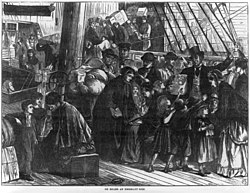 | |
| Other short titles |
|
|---|---|
| Long title | An Act to regulate the carriage of passengers by sea. |
| Nicknames | Passenger Act, 1882 |
| Enacted by | the 47th United States Congress |
| Effective | October 31, 1882 |
| Citations | |
| Public law | Pub. L. 47–374 |
| Statutes at Large | 22 Stat. 186, Chap. 374 |
| Codification | |
| Titles amended | 46 U.S.C.: Shipping |
| U.S.C. sections created | 46 U.S.C. ch. 601 § 60101 |
| Legislative history | |
| |
The Passenger Act of 1882 is a United States federal statute establishing occupancy control regulations for seafaring passenger ships completing Atlantic and Pacific transoceanic crossings to America during the late 19th century and early 20th century. The Act of Congress sanctioned vessel compartment dimensions in cubic feet comparable to the level within a ship's deck. The public law authorized the numerical serialization of berths which were subject to compartment occupancy inspections of emigrants and ocean liner passengers. The Law of the United States accentuated and endorsed a regulatory clause stating no person, on arrival of a vessel in a port, will be allowed to go aboard a passenger ship necessitating a bow to stern inspection.
Contents
- Provisions of the Act
- Summary of United States statute protocols
- Associated United States Federal Statutes
- See also
- Reading Bibliography
- External links
The Immigration Act of 1882 was simultaneously presented during the 47th United States congressional session which was enacted into law on August 3, 1882. The H.R. 6722 bill was passed by the 47th congressional session and enacted into law by the 21st President of the United States Chester Arthur on August 2, 1882.






